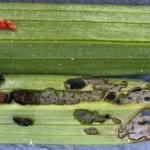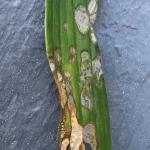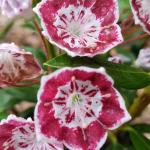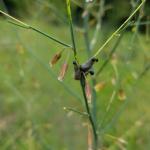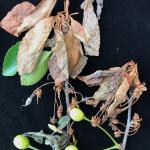HAPPY FATHER'S DAY!
UMass Extension's Landscape Message is an educational newsletter intended to inform and guide Massachusetts Green Industry professionals in the management of our collective landscape. Detailed reports from scouts and Extension specialists on growing conditions, pest activity, and cultural practices for the management of woody ornamentals, trees, and turf are regular features. The following issue has been updated to provide timely management information and the latest regional news and environmental data.
To read individual sections of the message, click on the section headings below to expand the content:
Scouting Information by Region
Environmental Data
The following data was collected on or about June 13, 2018. Total accumulated growing degree days (GDD) represent the heating units above a 50° F baseline temperature collected via our instruments for the 2018 calendar year. This information is intended for use as a guide for monitoring the developmental stages of pests in your location and planning management strategies accordingly.
|
MA Region/Location |
GDD |
Soil Temp |
Precipitation |
Time/Date of Readings |
||
|
1-Week Gain |
2018 Total |
Sun |
Shade |
|||
|
Cape Cod |
73.5 |
428 |
64 |
60 |
0 |
1:00 PM 6/13 |
|
Southeast |
76 |
450 |
68 |
61 |
0.25 |
5:30 PM 6/13 |
|
North Shore |
n/a |
537* |
63 |
56 |
0.01 |
9:00 AM 6/13 |
|
East |
94.5 |
604.5 |
65 |
62 |
0 |
4:00 PM 6/12 |
|
Metro West |
14.5 |
541 |
60 |
58 |
0 |
6:45 AM 6/12 |
|
Central |
81 |
482 |
60 |
52 |
0 |
7:00 AM 6/13 |
|
Pioneer Valley |
99 |
611 |
67 |
61 |
0 |
10:00 AM 6/13 |
|
Berkshires |
79 |
572 |
67 |
58 |
0 |
8:00 AM 6/13 |
|
AVERAGE |
74 |
528 |
64 |
59 |
0.03 |
- |
|
n/a = information not available * revised accumulation due to equipment malfunction |
||||||
Drought conditions update: As of June 14, Massachusetts is experiencing level D0 - 'Abnormally Dry' - in almost all of Middlesex County, the northwestern two-thirds of Essex County and the northeastern two thirds of Worcester County. Use this link to see the map:
http://droughtmonitor.unl.edu/CurrentMap/StateDroughtMonitor.aspx?MA
Phenology
| Indicator Plants - Stages of Flowering (BEGIN, BEGIN/FULL, FULL, FULL/END, END) | ||||||||
|---|---|---|---|---|---|---|---|---|
| PLANT NAME (Botanic/ Common) | CAPE | S.E. | N.S. | EAST | METRO W. | CENT. | P.V. | BERK. |
|
Ligustrum spp. (Privet) |
Begin |
Begin |
Begin |
Begin |
Begin |
Begin |
Begin |
* |
|
Catalpa speciosa (Northern Catalpa) |
* |
Begin/Full |
Begin/Full |
Begin/Full |
Begin |
Begin |
Full |
* |
|
Syringa reticulata (Japanese Tree Lilac) |
* |
Full |
* |
Begin/Full |
Begin |
Begin |
Begin/Full |
* |
|
Cladrastis lutea (Yellowwood) |
Begin/Full |
Full |
* |
* |
Full |
Full |
Begin |
Full |
|
Philadelphus spp.(Mockorange) |
Full |
Full |
Full |
Full |
Full |
Full |
Full |
Begin/Full |
|
Hydrangea anomala petiolaris (Climbing Hydrangea) |
Begin/Full |
Full |
Full |
Full |
Full |
Full |
Full |
Full |
|
Kalmia latifolia (Mountain-laurel) |
Begin |
Full |
Begin/Full |
Begin/Full |
Full |
Begin |
Full/End |
Full |
|
Cotinus coggygria (Common Smokebush) |
Begin/Full |
End |
Full |
Full |
Full |
Begin/Full |
Full |
Full |
|
Cornus sericea (Red Osier Dogwood) |
Begin/Full |
Full |
Full |
* |
Full/End |
Full/End |
Full/End |
Full/End |
|
Cornus kousa (Kousa Dogwood) |
Full |
Full |
Full |
Full |
Full/End |
Full |
Full |
Full |
|
Kolkwitzia amabilis (Beautybush) |
* |
Full |
Full/End |
End |
Full/End |
Full/End |
End |
Full |
| * = no activity to report/information not available | ||||||||
Regional Notes
Cape Cod Region (Barnstable)
General Conditions: The average temperature over the last week was 61°F with a high of 78°F on June 9 and a low of 45°F on June 7. Night time temperatures are a little cooler than one would expect for this time of year with several nights dipping into the 40s. Conditions have been great for working outdoors. No precipitation fell during this period resulting in topsoil moisture conditions that are short, subsoil moisture conditions remain adequate.
Pests/Problems: Cankerworm (spring or fall) can be found feeding on deciduous trees and may be mistaken as winter moth. Gypsy moth can be seen primarily on the outer Cape some minor damage can be observed in the upper Cape. Other pests or damage observed this week include: Viburnum leaf beetle larvae (Pyrrhalta viburni) feeding on Viburnum, Lecanium scale on white oak (Quercus alba) and Corylus avellana ‘contorta’, rose slug sawfly larvae feeding on rose, columbine leafminer (Phytomyza aquilegivora) on columbine, slugs on bearded iris, native holly leafminer (Phytomyza ilicicola) on American holly, brown rot on ‘Kwanzan cherry’, sycamore anthracnose on sycamore, spot anthracnose on dogwood, cedar apple rust on crabapple, turpentine beetle on pitch pine, black spot on rose, Exobasidium gall on azalea, Volutella canker on boxwood, peach leaf curl on peach, downy mildew on ornamental hops, and red thread rampant in turf. The following weeds can be found in bloom: multiflora rose, (Rosa multiflora), black swallowwort (Cynanchum nigrum), oriental bittersweet (Celastrus orbiculatus), mouse-ear chickweed (Cerastium vulgatum), red sorrel (Rumex acetosella), curly dock (Rumex crispus), annual fleabane (Erigeron annus), narrowleaf plantain (Plantago lanceolata), black medic, (Medicago lupulina), hawkweed (Hieracium spp.), and white clover (Tricolium repens). Rabbits are abundant. Black legged ticks (deer tick) nymphs are active so keep your self protected with permethrin treated shoes and clothing.
Southeast Region (Hanson)
General Conditions: This past week was a repeat of the week before with pleasant summer weather, temperatures in the mid-high 70’s and low 80’s, cooling off at night. Two nights had overnight lows of 48 degrees - a bit chilly for June. Rain was scarce this past week, with soils drying out and supplemental watering needed in managed landscapes. Hanson received 0.25 inches of rain and more is definitely needed. Continue to remind clients to water newly planted and transplanted plants.
The following plants are in bloom: Liriodendron tulipifera (tuliptree), Aesculus x carnea, Cornus kousa, Cladrastis kentukea, Magnolia virginiana (sweetbay magnolia), Styrax japonicus, Sinocalycanthus chinensis, Wisteria frutescens, Rosa rugosa hybrid ‘Linda Campbell’, ‘Knockout’ roses, Rosa rugosa, Hydrangea anomala petiolaris, Spiraea spp., Rhododendron spp., Kalmia, Physocarpus opulifolius (eastern ninebark), Calycanthus floridus (common sweetshrub), Indigofera spp., Clematis spp., Viburnum dilatatum (linden Viburnum), Viburnum dentatum (arrowwood Viburnum), Syringa x prestoniae ‘James Macfarlane’, beautybush, Lonicera sempervirens, Lonicera ‘John Clayton’ spp., early daylilies, Salvia spp., bearded Iris, Geranium spp., Thalictrum aquilegifolium, Anemone canadensis, Doronicum spp., Lamium, Allium, Baptisia australis, Dianthus spp., Tradescantia, lupines, Corydalis lutea, Valeriana officinalis, peonies and Aquilegia (columbine).
Cotinus obovatus (American smoketree) and Cotinus coggygria (European smokebush) have ended bloom but are now producing their colorful “smoke” which are plume-like hairs that form on the sterile flowers (photo 1). The ‘smoke’ is an attractive landscape feature and will remain for several weeks. Itea virginica, Weston hybrid azaleas, and foxgloves are beginning bloom. Rhus typhina (staghorn sumac), a native plant, is in full bloom with its small greenish flowers. Although the flowers are not very ornamental, they attract a great number of pollinators, including honey bees. White pines have finally finished producing and distributing their yellow pollen and what a year it was! Almost anyone working outdoors was choking on that pollen! Hopefully, it will rain and clear the pollen off the foliage and everything else. In many areas, for the fourth year in a row, the overwintering stems of most Hydrangea macrophylla were winter-killed and or bud-killed, leaving brown dead ‘sticks’ and no flower buds. The more cold-hardy hybrids like Hydrangea macrophylla ‘Blue Billow’, H. ‘Preziosa’, or H. ‘Lady-in-red’ are producing flower buds, as well as are the remontant, or repeat-blooming, Hydrangea macrophylla, which produce flowers on new wood. Check out “Plant of the Month” in Garden Clippings, May 1, 2018: http://ag.umass.edu/home-lawn-garden/newsletters/garden-clippings/garden-clippings-2018-vol-373
Pests/Problems: Gypsy moth caterpillars are actively feeding on plants, mainly oaks, and are at 4th instar stage with some 5th instars. For the past week, in oak trees where there were numerous gypsy moth caterpillars feeding, the sound of falling frass (caterpillar feces) could be heard like gentle rain falling. Today when scouting, there seemed to be fewer caterpillars at the same sites monitored last week and the frass-falling sound has diminished. Whether the caterpillar numbers are reduced, or not, remains to be seen. I have not seen any sign of sickened or dying caterpillars. Overall, as of right now, field observations indicate that trees are looking good. However, continue to monitor trees and other plants. As the Gypsy moth caterpillars get to be 5th instar (males) and 6th instar (females), they can eat huge amounts of foliage in a very short time.
Asiatic garden beetles have emerged. These small, copper-colored beetles feed at night on a wide range of plant material; they are attracted to lights at night and can often be seen clinging to screen doors and window screens when lights are on. Hibiscus sawfly larvae are active on perennial hibiscus. Monitor foliage and look for Swiss-cheese like holes (photo 2). Turn the leaf over, and you may see the greenish-clear, slug-like larvae (photo 3). Manage this insect early as the voracious larvae can devour the foliage. Lily leaf beetles (photo 4) are active and laying red, oval-shaped eggs and the feces-covered larvae are also active (photo 5). Look for damage to lily leaves (photo 6) and manage this pest now. Handpick and destroy beetles, eggs, and larvae or manage with a labeled insecticide according to instructions.
Monitor dogwoods for dogwood sawfly larvae which should soon be active on certain dogwood species like Cornus controversa, Cornus racemosa and Cornus sericea. Mosquitoes are really active; continue to remind clients to empty containers of standing water or to treat with Bacillus thuringiensis israelensis (Bti). Euonymus caterpillars have finished feeding and have pupated. The following insects and pests are active: golden tortoise beetle, European chafer beetle, lacebugs on Japanese Andromeda (Pieris japonica), Rhododendron and azaleas, roseslug sawfly, White pine sawyer beetle (an Asian longhorned beetle look-alike), Cottony camellia scale on Meserve hollies and Taxus, Hemlock woolly adelgid, elongate hemlock scale, Taxus mealybug, aphids, stink bugs,slugs, snails, earwigs, four-lined plant bugs, wasps, hornets, deer flies, horse flies and dog ticks. Deer tick nymphs remain active – see the Insect Section of the Landscape Message.Beneficial insects remain active; remember to caution clients to identify insects before applying insecticides. The larvae of ladybugs (lady beetles) may look scary, but they eat so many aphids!
Leaf spots are showing up on dogwood and crabapple, blackspot on roses, Monilinia (brown rot) on Kwanzan cherry, and botrytis blight on peonies. Phyllosticta hamamelidis (witchhazel blight) continues to turn the foliage brown on ‘Arnold Promise’ witchhazel (photo 7). This fungus seems to affect ‘Arnold Promise’ and is not showing up on other witchhazels at the Hanson site, as well as at a site in Halifax, MA. Monitor azaleas for Azalea leaf galls (Exobasidium vaccinii) and if found, remove and place in the trash. The following weeds are in bloom: multiflora rose (Massachusetts invasive plant), oxeye daisy, red and white clover, black swallowwort (invasive), hawkweed, buttercup and veronica.
North Shore Region (Beverly)
General Conditions: The weather during this reporting period was very comfortable for outdoor activities. The days were mainly sunny or partially sunny. Day temperatures were in the low to mid 70s and the night temperatures were mainly in the low 50s. We gained 106 growing degree days at Long Hill during this reporting period. It was also a very dry week. At Long Hill we recorded only 0.01 inches of rainfall during this period. Woody plants seen in bloom include: Chinese dogwood (Cornus kousa), arrowwood Viburnum (Viburnum dentatum), Chinese Neillia (Neillia sinensis), magician Deutzia (Deutzia magicien), fringe tree (Chionanthus virginicus), mock orange (Philadelphus spp.), beautybush (Kolkwitzia amabilis), Betty Layman azalea (Rhododendron ‘Betty Layman’), mountain laurel (Kalmia latifolia), Weigela (Weigela florida), mapleleaf Viburnum (Viburnum acerifolium), tulip tree (Liriodendron tulipifera), Korean dogwood (Cornus coreana), American holly (Ilex opaca) and Japanese snowbell (Styrax japonica). Non-woody plants seen in bloom include: bush cinquefoil (Potentilla fruticosa), foam flower (Tiarella cordifolia), fetterbush (Leucothoe fontanesiana), Scotch rose (Rosa spinosissima), peony (Paeonia spp.), cranesbill (Geranium spp.), bleeding heart (Dicentra spectabilis), redleaf rose (Rosa glauca), Rodger's flower (Rodgersia aesculifolia), goat’s beard (Aruncus dioicus), Japanese primrose (Primula japonica), water lily (Nymphaea odorata), columbine (Aquilegia spp.), sweet woodruff (Galium odoratum) and annuals.
Pests/Problems: Damage by rose slug sawfly was observed on some rose plants. The leaves of some of the plants were completely skeletonized. Skeletonized leaf damage by Viburnum leaf beetle continued to be observed on American cranberry Viburnum. Leaf and flower galls (Exobasidium vaccinii) continue to be observed on some azalea. Prune the galls and discard before they start to release spores. Multiflora rose (Rosa multiflora ) and wild raspberry (Rubus rosifolius) weeds are in full bloom and are easy to identify. Ticks and mosquitoes are very active. Make sure you protect yourself with appropriate repellants before you go out into areas with vegetation, especially out in the woods.
East Region (Boston)
General Conditions: Temperatures have been seasonal over the last week. High temperatures have ranged from 66°F to 80°F, averaging 74°F. Low temperatures have seen less fluctuation, ranging from 51°F to 57°F, averaging 53°F. We gained 94.5 GDDs this week bringing the total to 604.5 GDDs for this year. We received no precipitation; supplemental irrigation is necessary on newly planted trees and shrubs. Plants in bloom include: Amorpha fruticosa (leadwort), Buddleia alternifolia (fountain butterflybush), Calycanthus chinensis (Chinese sweetshrub), Clematis spp./cultivars (Clematis), Cornus koussa (Kousa dogwood), Digitalis purpurea (common foxglove), Lamium maculatum 'White Nancy' (spotted deadnettle), Lysimachia punctata (yellow loosestrife), Nepeta spp. (catmint), Oenothera macrocarpa (Ozark sundrop), Paeonia spp. (peony), Physocarpus opulifolius (ninebark), Platycodon grandiflorus (balloon flower), Potentilla fruticosa (shrubby cinquefoil), Rosa rugosa (rugosa rose), Rosa ‘Bucbi’ (“Carefree Beauty” rose), Salvia officinalis (common sage), and Spiraea japonica (Japanese meadowsweet). Trifolium repens (white clover) in turf is in full bloom in unmown areas.
Pests/Problems: The lack of rain has left soils dry; soils with high organic matter are very dusty, while those lacking organic matter are hard and dry. Wood weeds Rosa multiflora (multiflora rose) and Toxicodendron radicans (poison ivy) are in bloom. Many herbaceous weeds are in bloom in mulched beds and neglected areas including Cynanchum louisae (black swallowwort), Galinsoga quadriradiata (hairy Galinsoga), Medicago lupulina (black medic), Mullugo verticillata (carpetweed), Oxalis stricta (yellow woodsorrel), Rumex acetosella (red sorrel), R. crispus (curly dock), R. obtusifolius (broadlead dock), Solanum dulcamara (bittersweet nightshade), Spergularia rubra (red sandspurry), Urtica dioica (stinging nettle), and Veronica arvensis (corn speedwell). Newly germinated weeds include Acalypha rhomboidea (rhombic copperleaf), Ambrosia artemisiifolia (common ragweed), Digitaria ischaemum (smooth crabgrass), D. sanguinalis (hairy crabgrass), Euphorbia maculata (spotted spurge), and Portulaca oleracea (common purslane). Viburnum leaf roller caterpillars are highly visible on Viburnum lantana var. discolor (wayfaring tree). Viburnum leaf beetle larvae have dropped from the leaves and are pupating in the soil. Leaf miners are visible on Aquilegia spp. (columbine). Pollen levels are high due to the lack of rain and the abundance of flowering grasses.
Metro West (Acton)
General Conditions: The landscape is lush and colorful with all that is in bloom. In some stage of bloom at this time are the following woody plants: Catalpa speciosa (northern Catalpa), Chionanthus retusus (Chinese fringe tree), C. virginicus (fringe tree), Cladrastis lutea (yellowwood), Cornus kousa (kousa dogwood), C. x rutgersensis 'Ruth Ellen' (Rutgers hybrid dogwood), Cornus sericea (redosier dogwood), Cotinus coggygria (common smokebush), Crataegus spp. (hawthorn), Kalmia latifolia (mountain laurel), Kolkwitzia amabilis (beautybush), Leucothoe axillaris (coast Leucothoe), Ligustrum spp. (privet), Liriodendron tulipifera (tulip tree), Philadelphus coronarius (sweet mock orange), Physocarpus opulifolius (common ninebark), P. opulifolius 'Summer Wine' (summer wine ninebark), Potentilla fruiticosa (Potentilla), Rhododendron spp. (Rhododendron and azalea), Robinia pseudoacacia (black locust), Rosa rugosa (rose), R. 'Knockout' (the Knockout family of roses), Rosa spp. (rose), Rubus spp. (blackberry, bramble, raspberry), Sambucus canadensis (elderberry), Spirea japonica 'Alpina' (Daphne spirea), Spirea spp. (bridal wreath), Syringa reticulata (Japanese tree lilac), Viburnum cassinoides (witherod Viburnum) and Weigela florida (old fashioned Weigela). Woody vines in bloom are: Clematis spp. (Clematis), Lonicera sempirvirens (trumpet honeysuckle) and Wisteria spp. (Wisteria). Contributing even more color and interest to the landscape are some flowering herbaceous plants including: Achillea millefoliumn (yarrow), Alchemilla mollis (lady's mantle), Allium giganteum (giant onion), A. schoenoprasum (chives), Aquilegia vulgaris (columbine), Amsonia hubrichtii (Arkansas blue star), Aruncus dioicus (goat’s beard), Baptisia australis (false blue indigo), Campanula persicifolia (peach-leafed bell flower), C. takesimana ‘Elizabeth’ (bellflower), Chrysogonum virginianum (green and gold), Clematis recta 'Purpurea' (Clematis), Dianthus deltoides (maiden pinks), Dicentra eximia (fringed bleeding heart), Dictamnus albus (gas plant), Digitalis purpurea (foxglove), Filipendula spp. (meadow sweet), Geranium cantabrigiense 'Biokovo' and 'Cambridge' (hardy cranesbill), G. macrorrhizum (bigroot Geranium), G. sanguineum (cranesbill Geranium), Gillenia trifoliata (bowman’s root), Hemerocallis 'Stella D'Oro' (daylily) and H. spp. (daylily), Heuchera spp. (coral bells), Iris germanica (bearded Iris), I. versicolor (blue flag Iris), Lupinus 'Russell Woodfield Hybrids' (Lupine), Leucanthemum spp. (shasta daisy), Maianthemum racemosum (false Solomon’s seal), Nepeta spp. (ornamental catmint), Oenothera macrocarpa (Ozark sundrops), Paeonia spp. (Peony), Papaver orientale (poppy), Penstemon digitalis 'Husker Red' (beardtongue), Potentilla tridentata (cinquefoil), Primula spp. (primrose), Salvia nemerosa (Salvia), Silene latifolia (white campion), Thymus praecox (thyme), Tradescantia spp. (spiderwort) and Veronica spp. (speedwell).
Pests/Problems: Without any precipitation recorded during this last reporting period, the lack of rainfall continues to be a concern, particularly this early in the growing season and in the midst of spring planting. The historical monthly average rainfall for June is 3.93” and the total for the month so far is now at 0.63”. Rosa multiflora, an aggressive vine, continues to bloom and is very easy to detect with its abundant white flowers and is seen growing in and amongst other trees and shrubs. Ticks and mosquitoes are feeding and active.
Central Region (Boylston)
General Conditions: This past week has been much drier with no recorded rainfall. The kousa dogwoods (Cornus kousa) are still looking great. Climbing hydrangea is looking spectacular this year with the most number of blooms noted in many years. The seeds of eastern cottonwood (Populus deltoides), noted for the last few weeks floating on the wind, almost look like snow on a windy day. Knock out roses (Rosa glauca, R. rugosa, R. ‘New Dawn’) and ninebark (Physocarpus opulifolius cvs) are completely covered in flowers. Mockorange (Philadelphus ‘Glacier’) is still looking fabulous this week. Mountain laurels (Kalmia latifolia cultivars) are just starting to come into bloom. Trumpet honeysuckle (Lonicera sempervirens cvs.) is in full bloom, as are mapleleaf Viburnum (Viburnum acerifolium) (Photo credit TJ Sullivan) and tulip popular (Liriodendron tulipifera). Herbaceous perennials and bulbs in bloom include: the beardtongues (Penstemon spp.) such as (P. ‘Prairie Dusk’), (P. barbatus subsp. barbatus), (P. digitalis ‘Husker’s Red’), spiderwort (Tradescantia ‘Sweet Kate’), Yarrows (Achillea ‘Moonshine’, A. ‘Coronation Gold’, A. ‘Paprika’), cancerweed (Salvia lyrata ‘Purple Knockout’), woodland sage (Salvia nemorsa ‘Ostfriesland’), and golden garlic (Allium moly).
Pests/Problems: Some new pest activity noted for this week: 3-lined potato beetle is active, mating and egg laying on several solanaceae plants such as flowering tobacco (Nicotiana spp.) and tomatillo (Physalis ixocarpa). Asparagus beetle is hatching and feeding. Swiss chard is riddled with spinach leafminer galleries. Bald-faced hornet nests were observed at golf ball-sized stage in the gardens. Gypsy moth caterpillar damage was noted on severely infested trees which are at the complete defoliation stage in many areas.
Pioneer Valley Region (Amherst)
General Conditions: As we settle into mid-June, we experienced a dry but pleasant week of weather in the Pioneer Valley. In Northampton, high temperatures ranged between 73–81°F while low temperatures ranged from 46–54°F. Winds have been stronger as of late, with gusts from 20–30 mph recorded at Barnes Airport in Westfield on 6/12 and 6/13. Late spring color is still abundant with a variety of annuals, perennials, shrubs and trees in varying stages of flowering at this time. Many landscape conifers have luxuriant new growth as shoots and needles continue to develop. Soil temperatures remain in the lower to middle 60s, but soils continue to dry with the lack of precipitation across the region. Turf grass growth is slowing dramatically and lawns are browning out in exposed settings but are mostly green under shade. The most recent drought intensity map shows abnormally dry conditions expanding east of the Connecticut Valley (http://droughtmonitor.unl.edu/CurrentMap/StateDroughtMonitor.aspx?MA), but at present, only a sliver of eastern Franklin County is included. Regardless, continue to irrigate newly transplanted trees and shrubs, but avoid overhead irrigation if possible. Overhead irrigation often does not provide sufficient water to tree and shrub roots, especially when surrounding turf is absorbing most of the water. In addition, overhead watering wets the canopy and provides the necessary moisture for leaf/needle and stem cankering pathogens to invade.
Pests/Problems: The dry conditions have suppressed many plant pathogens, so there is a bright side to the dry weather. While 2017 was an exceptional year for many anthracnose diseases, the incidence and severity this year is much lower. Using sycamore as a bellwether illustrates this point, as many mature trees have full canopies with only minor dieback due to anthracnose at this time. Despite the lower incidence, anthracnose of oak, maple and cherry (just to name a few) is present in the landscape and severity depends on local rainfall rates and sun exposure at the site, among other factors. Cedar-apple rust leaf spots on apple and crabapple (Malus) are becoming more prominent. These orange-colored spots with a yellow margin will continue to expand in the weeks ahead. While often a minor disease of landscape trees, some apple cultivars are highly susceptible, such as the espalier apple pictured below. Horsechestnut leaf blotch is becoming more conspicuous. Right now, the disease appears as pale brown, water-soaked lesions scattered across the leaf surface. Dutch elm disease is beginning to rear its ugly head on the landscape. Look for yellowing and browning branches in the upper canopy. Infected branches should be pruned immediately to stop the progression of the pathogen in the vascular tissue. Therapeutic injections are usually performed using Alamo (propiconazole). Continue to scout for and treat conifers infested by the spruce spider mite. This pervasive landscape pest is very active right now with the mild temperatures and lack of rainfall. Thin webbing over shoots and needles can be observed on infested trees. While damage on new growth is not yet visible, flecking symptoms on older needles should be readily apparent with careful observation. Lacebug injury on serviceberry and azalea is visible at this time. The symptoms appear as flecking or skeletonizing on the upper leaf surface. Congregating adult lacebugs, egg masses and frass can be observed on the underside of the infested foliage. Treat now to avoid additional damage as the season progresses. Squirrels, chipmunks, rabbits and skunks continue to cause headaches in the landscape with their unrelenting burrowing, digging, chewing, scratching and eating of flowers, fruits, leaves and stems.
Berkshire Region (Great Barrington)
General Conditions: No rain fell during the monitoring period and soil moisture was low with the upper soil layers being bone dry. Some rain is expected on 6/13 but the showers look to be spotty and well below what is needed. Day time temperatures have been at or just above normal but night time temperatures were frequently in the mid to upper 40s. Humidity was low throughout the period, making for very pleasant day time conditions. The lack of rain and a few windy days, however, are starting to affect lawns. Some non-irrigated lawns on well-drained soils are showing some browned grass. Mature landscape plants appear to be holding up well given the dry weather, perhaps because there is sufficient rooting in lower layers that are somewhat moist. It has been a banner year for pine pollen as everything from plants to automobiles to walks and decks are coated with a fine yellow dust – the pollen. It has also been a banner year for release of dandelion seeds. The seeds (technically fruit) have feathery tufts attached which allow them to be easily blown about by wind. At times, there are so many of the seeds floating about that it seems more like a snow storm than natural seed dispersal. Another “weed” of note is the multiflora rose (Rosa multiflora), the iconic invasive plant. It is now in full bloom and is the dominant flowering plant along rural roadways and field perimeters.
Pests/Problems: Ongoing pest issues are: imported willow leaf beetle (larval stage), woolly beech aphid, boxwood psyllid, boxwood leaf miner (adult flies), and euonymus scale (crawlers and settled scales). Eastern tent caterpillars have abandoned their web nests and have begun to pupate. Viburnum leaf beetle larvae have finished feeding and are not to be found on Viburnum foliage, indicating that they have dropped to the ground and entered the soil to pupate. Aphids are appearing on a number of plants. Elderberry borer was found on Sambucus nigra ‘Black Lace’. The blisters of pear leaf blister mite were observed on espalier pears. An assortment of galls is appearing on the leaves of many tree species, notably oaks, hickories and maples, but leaf galls are not limited to these species. Perhaps it’s because of the dry weather but few diseases have been observed. The remnants of fire blight are still visible on Prunus x cisterna. Cedar apple rust and apple scab are prominent on crabapples. Black-legged ticks, mosquitoes, gnats, carpenter bees and wasps remain plentiful.
Regional Scouting Credits
- CAPE COD REGION - Russell Norton, Horticulture and Agriculture Educator with Cape Cod Cooperative Extension, reporting from Barnstable.
- SOUTHEAST REGION - Deborah Swanson, UMass Extension Horticulturist for Plymouth County - Retired, reporting from Hanson.
- NORTH SHORE REGION - Geoffrey Njue, Green Industry Specialist, UMass Extension, reporting from the Long Hill Reservation, Beverly.
- EAST REGION - Kit Ganshaw & Sue Pfeiffer, Horticulturists, reporting from the Arnold Arboretum, Jamaica Plain.
- METRO WEST REGION - Julie Coop, Forester, Massachusetts Department of Conservation & Recreation, reporting from Acton.
- CENTRAL REGION - Dawn Davies, Interim Horticulture Manager, reporting from Tower Hill Botanic Garden, Boylston.
- PIONEER VALLEY REGION - Nick Brazee, Plant Pathologist, UMass Extension Plant Diagnostic Lab, reporting from UMass Amherst.
- BERKSHIRE REGION - Ron Kujawski, Horticultural Consultant, reporting from Great Barrington.
Woody Ornamentals
Diseases
Dutch elm disease, caused by Ophiostoma novo-ulmi, on American elm (Ulmus americana). Tree is 35-years-old and resides in full sun with wet, clay soils. An arborist noticed sections of the canopy starting to wilt and an adjacent elm had a middle leader die last autumn. Vascular staining was observed in the vascular tissue of the submitted stems and branches and after a brief incubation of the stained wood, Ophiostoma emerged.
Phomopsis stem cankering and an infestation of the San Jose scale (Quadraspidiotus perniciosus) on an espalier crabapple (Malus sp.). Tree is approximately 3” in diameter and was planted one year ago. Oddly, the tree retained many of its leaves over the winter and this season is exhibiting leaf and stem dieback. The San Jose scale was introduced from China over 100 years ago and is most common on fruit trees like apple and pear, but also infests cherry, peach and plum.
Phomopsis stem cankering and an infestation of the spruce bud scale (Physokermes piceae) on Norway spruce (Picea abies). Tree is 15-years-old and was transplanted five years ago to a residential landscape with heavy loam soils and full sun. Lower canopy branches are exhibiting needle browning/yellowing and a general decline. Phomopsis is quite common on stems and small branches of declining spruce, especially blue spruce. The bud scale infestation was minor to moderate based on the sample. This soft-bodied scale is most common on Norway and dwarf Alberta spruce in the landscape.
Infestation of the oak shothole leafminer (Agromyza viridula) on white oak (Quercus alba). The tree is approximately 100-years-old and is growing in an open setting in a wildland trust. As is the case for many old trees, various pests and pathogens have caused problems in the past. Chief among these pests, humans, installed turf around the tree several years ago. In 2016, this oak was badly defoliated by gypsy moth but foliar treatments have prevented significant damage over the past two years. However, in 2017 the tree was suffering from Tubakia leaf spot and a jumping gall wasp infestation. The oak shothole leafminer creates small, circular holes across the foliage. Typically, the damage is not severe.
Maple anthracnose, caused by Aureobasidium apocryptum on red maple (Acer rubrum). Tree is 15-years-old and has been present at the site for four years. Tree was installed in a lawn area with an irrigation system and half sun. This spring, the tree flushed new growth and appeared healthy, but has quickly declined since the beginning of June. Additional red maples on the property appear unaffected. Anthracnose outbreaks can be highly localized even when other susceptible hosts are nearby.
Report by Nick Brazee, Plant Pathologist, UMass Extension Plant Diagnostic Lab, UMass Amherst.
Insects
Woody ornamental insect and non-insect arthropod pests to consider, a selected few:

 Gypsy Moth:(Lymantria dispar) host plants include but are certainly not limited to oak (favored), maple, birch, poplar, and many others. Gypsy moth caterpillars continue to feed and grow in size. Caterpillars observed on 6/13/18 in Amherst, MA are just over 1 inch in length. It seems, at this location, that many are still in the 4th instar. Caterpillars may be of different sizes, depending upon your location in MA. (See Regional Reports above.) Caterpillars now have the red and blue pairs of warts or raised bumps recognizable in older gypsy moth caterpillars. They also have yellow coloration to their head capsule.
Gypsy Moth:(Lymantria dispar) host plants include but are certainly not limited to oak (favored), maple, birch, poplar, and many others. Gypsy moth caterpillars continue to feed and grow in size. Caterpillars observed on 6/13/18 in Amherst, MA are just over 1 inch in length. It seems, at this location, that many are still in the 4th instar. Caterpillars may be of different sizes, depending upon your location in MA. (See Regional Reports above.) Caterpillars now have the red and blue pairs of warts or raised bumps recognizable in older gypsy moth caterpillars. They also have yellow coloration to their head capsule.
Between now and July 1st, if gypsy moth caterpillars are present in large enough numbers, defoliation will become more apparent as caterpillars continue to grow in size and feed. Thanks to Entomophaga maimaiga, hopefully we will not see entire hillsides of defoliation, as was seen by July 1st in 2017 in Belchertown, MA. (See last year’s Landscape Message.)
Despite the fungal outbreak that swept through the 2017 caterpillar population, some lucky caterpillars survived to pupation and emerged as adult moths. (However, adults were present in 2017 in far fewer numbers than would have existed without the fungus.) While it is very difficult to predict how much defoliation Massachusetts will see in 2018 due to gypsy moth caterpillar feeding, we can be certain that in areas where many egg masses were seen overwintering, pockets of defoliation could still occur in certain areas of the state this year. Thanks to the gypsy moth caterpillar-killing fungus, however, the population should be on the decline, but we cannot expect the caterpillars to disappear completely from Massachusetts landscapes this season.
- Asian Longhorned Beetle: (Anoplophora glabripennis, ALB) Look for signs of an ALB infestation which include perfectly round exit holes (about the size of a dime), shallow oval or round scars in the bark where a female has chewed an egg site, or sawdust-like frass (excrement) on the ground nearby host trees or caught in between branches. Be advised that other, native insects may create perfectly round exit holes or sawdust-like frass, which can be confused with signs of ALB activity.
The regulated area for Asian longhorned beetle is 110 miles2 encompassing Worcester, Shrewsbury, Boylston, West Boylston and parts of Holden and Auburn. If you believe you have seen damage caused by this insect, such as exit holes or egg sites, on susceptible host trees like maple, please call the Asian Longhorned Beetle Eradication Program office in Worcester, MA at 508-852-8090 or toll free at 1-866-702-9938.
To report an Asian longhorned beetle find online or compare it to common insect look-alikes, visit: http://massnrc.org/pests/albreport.aspx or https://www.aphis.usda.gov/pests-diseases/alb/report .
- Deer Tick/Blacklegged Tick: Ixodes scapularis adult females, following a blood meal, can lay a single egg mass (up to 1500 – 2000 eggs) in mid-late May, then the female deer tick perishes. Larvae emerge from the eggs later in the summer. Larvae are tiny and six-legged. Prior to feeding, they are not known to be able to transmit disease. After feeding, the larvae drop from their host and molt, re-emerging the following spring as nymphs. Nymphs (from last year’s overwintering cohort) are active from May-August. Nymphs are eight-legged and about the size of the head of a pin. These tiny nymphs typically attach to small mammal hosts; however, they will readily feed on people and pets. Nymphs are capable of carrying Lyme disease, human Babesiosis, human Anaplasmosis and deer tick virus. For images of all deer tick life stages, along with an outline of the diseases they carry, visit: http://www.tickencounter.org/tick_identification/deer_tick .
Anyone working in the yard and garden should be aware that there is the potential to encounter deer ticks. The deer tick or blacklegged tick can transmit Lyme disease, human babesiosis, human anaplasmosis, and other diseases. Preventative activities, such as daily tick checks, wearing appropriate clothing, and permethrin treatments for clothing (according to label instructions) can aid in reducing the risk that a tick will become attached to your body. If a tick cannot attach and feed, it will not transmit disease. For more information about personal protective measures, visit: http://www.tickencounter.org/prevention/protect_yourself .
Have you just removed an attached tick from yourself or a loved one with a pair of tweezers? If so, consider sending the tick to the UMass Laboratory of Medical Zoology to be tested for disease causing pathogens. To submit a tick to be tested, visit: https://www.tickreport.com/ and click on the red “Test A Tick” button. Results are typically available within 3 business days, or less. By the time you make an appointment with your physician following the tick attachment, you may have the results back from TickReport to bring to your physician to aid in a conversation about risk.
The UMass Laboratory of Medical Zoology does not give medical advice, nor are the results of their tests diagnostic of human disease. Transmission of a pathogen from the tick to you is dependent upon how long the tick had been feeding, and each pathogen has its own transmission time. TickReport is an excellent measure of exposure risk for the tick (or ticks) that you send in to be tested. Feel free to print out and share your TickReport with your healthcare provider.
You can also follow TickReport on Twitter @TickReport for timely updates from the Laboratory of Medical Zoology, including the latest tick and tick-borne disease related research.
- Eastern Tent Caterpillar: Malacosoma americanum caterpillars continue to be observed wandering on paved and dirt roads in Chesterfield, MA on 6/13/18, yet the number of wandering caterpillars has significantly decreased in this location. Eastern tent caterpillars have likely begun to pupate in sheltered areas they locate, although not all individuals will do so at exactly the same time. Pupation for the species reportedly lasts around three weeks and adult moths historically emerge between late June and early July.
- Elongate Hemlock Scale: Fiorinia externa is found on eastern, Carolina, and Japanese hemlock, as well as yew, spruce and fir. Crawlers will be present this month and throughout the growing season and the overlap of many developmental stages at any given time can be observed. Treatments (active ingredients effective through contact) for the crawler, or mobile, stage of this insect may be made in late May through mid-June, or between 360-700 GDD’s, base 50°F. (Systemic options can be made at other times, such as the spring and fall.)
- Emerald Ash Borer: (Agrilus planipennis, EAB) This wood-boring beetle readily attacks ash (Fraxinus spp.) including white, green and black ash. It has also been found developing in white fringe tree (Chionanthus virginicus) and most recently has been reported in cultivated olive (Olea europaea). Signs of an EAB infested tree may include D-shaped exit holes in the bark (from adult emergence), “blonding” or lighter coloration of the ash bark from woodpecker feeding (chipping away of the bark as they search for larvae beneath) and serpentine galleries visible through splits in the bark from larval feeding beneath. Positive identification of an EAB-infested tree may not be possible with these signs individually on their own.
For further information about this insect, please visit: https://ag.umass.edu/fact-sheets/emerald-ash-borer . If you believe you have located EAB-infested ash trees, particularly in an area of Massachusetts not identified on the map provided, please report here: http://massnrc.org/pests/pestreports.htm .

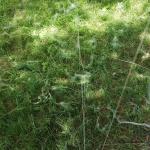
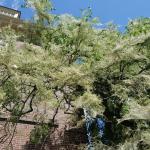



 Euonymus Caterpillar: Yponomeuta cagnagella is of European origin and widespread in distribution throughout Europe. It was first reported in North America in Ontario in 1967. On 6/11/2018, a common spindle tree (Euonymus europaeus) on the UMass Amherst campus was found with a heavy infestation of euonymus caterpillars. The infested tree is approximately 3.1 miles away from the initial area in Amherst, MA reported on for this insect. On 6/11/18 in this location, the majority of caterpillars were found to be spinning white cocoons within which they pupate. Large sections of this individual tree are covered in webbing and cocoons. Webbing falling from the tree covers the turf below, and some caterpillars are pupating in clumps of webbed turf.
Euonymus Caterpillar: Yponomeuta cagnagella is of European origin and widespread in distribution throughout Europe. It was first reported in North America in Ontario in 1967. On 6/11/2018, a common spindle tree (Euonymus europaeus) on the UMass Amherst campus was found with a heavy infestation of euonymus caterpillars. The infested tree is approximately 3.1 miles away from the initial area in Amherst, MA reported on for this insect. On 6/11/18 in this location, the majority of caterpillars were found to be spinning white cocoons within which they pupate. Large sections of this individual tree are covered in webbing and cocoons. Webbing falling from the tree covers the turf below, and some caterpillars are pupating in clumps of webbed turf.
The euonymus caterpillars (larvae) feed in groups and envelop the foliage of the host plant in webs as they feed. Hosts include: Euonymus europaeus (tree form), E. kiautschovicus, E. alatus, and E. japonicus. Mature caterpillars are just under an inch in length, creamy yellow-gray in color with black spots and a black head capsule. By late June, these larvae pupate in white, oval-shaped cocoons which are typically oriented together vertically either on host plants or non-hosts in the area. (See photos.) Cocoons can be found in cracks and crevices, or webbed together leaves. The adult moth emerges in late June in most locations. The adult female secretes a gummy substance over her eggs which will harden, making them even more difficult to see. Eggs hatch by mid-August, at which time the tiny larvae prepare to overwinter beneath their eggshell-like covering. These larvae are inactive until the following year, when caterpillars group together to feed on newly emerging leaves, creating a mess of webs as they feed. There is one generation per year. Plants may be partially or entirely defoliated.
 European Elm Scale: Gossyparia spuria is a type of felt scale and was observed on an elm on 6/13/17 in Amherst, MA. This particular tree held populations of this insect in 2017 as well. First noted in New York in 1884, this non-native scale is now widespread in North America and is found on native and European elms, but also rarely on hackberry and Zelkova. This insect can cause yellowing of foliage, premature leaf drop, and eventually dieback on its host. Honeydew and thus sooty mold are produced. The females observed in Amherst have produced a ring of white fibers around their black, oval bodies. By the end of June, these females will lay eggs that hatch into bright yellow crawlers, which will disperse to the midrib and leaf veins on the underside of elm leaves where they will remain to feed. Crawlers are tiny and magnification is necessary to observe. Natural enemies such as parasitic wasps and predatory insects have been reported as successful in managing this insect.
European Elm Scale: Gossyparia spuria is a type of felt scale and was observed on an elm on 6/13/17 in Amherst, MA. This particular tree held populations of this insect in 2017 as well. First noted in New York in 1884, this non-native scale is now widespread in North America and is found on native and European elms, but also rarely on hackberry and Zelkova. This insect can cause yellowing of foliage, premature leaf drop, and eventually dieback on its host. Honeydew and thus sooty mold are produced. The females observed in Amherst have produced a ring of white fibers around their black, oval bodies. By the end of June, these females will lay eggs that hatch into bright yellow crawlers, which will disperse to the midrib and leaf veins on the underside of elm leaves where they will remain to feed. Crawlers are tiny and magnification is necessary to observe. Natural enemies such as parasitic wasps and predatory insects have been reported as successful in managing this insect. Forest Tent Caterpillar: Malacosoma disstria caterpillars were still seen in Amherst, MA on 6/13/2018. One such caterpillar was seen resting in between the cracks and crevices of ash (Fraxinus spp.) bark. Forest tent caterpillars are still significantly larger than gypsy moth caterpillars in this location at this time. They are hairy with visible blue lateral stripes and white “key-hole” or “penguin”-shaped spots from head to hind end dorsally. Susceptible hosts whose leaves are fed on by this insect include oak, birch, ash, maple, elm, poplar and basswood.
Forest Tent Caterpillar: Malacosoma disstria caterpillars were still seen in Amherst, MA on 6/13/2018. One such caterpillar was seen resting in between the cracks and crevices of ash (Fraxinus spp.) bark. Forest tent caterpillars are still significantly larger than gypsy moth caterpillars in this location at this time. They are hairy with visible blue lateral stripes and white “key-hole” or “penguin”-shaped spots from head to hind end dorsally. Susceptible hosts whose leaves are fed on by this insect include oak, birch, ash, maple, elm, poplar and basswood.
- Hemlock Looper: Two species of geometrid moths in the genus Lambdina are native insects capable of defoliating eastern hemlock, balsam fir and white spruce. Adult moths lay their eggs on the trunk and limbs of hosts in September and October; eggs will hatch by late May or early June. Monitor susceptible hosts for small, inch-worm like caterpillars at this time. Where populations are low, no management is necessary.
- Imported Willow Leaf Beetle: Plagiodera versicolora overwintered adults are present and continue to be active and found on willow foliage. Adult beetles will chew holes and notches in the leaves of willow. Egg laying was observed on 5/16/18, 5/23/18, and 5/30/2018 in Chesterfield, MA.Females lay yellow eggs in clusters on the undersides of leaves. As of 5/30/2018, eggs have hatched at the location in Chesterfield, MA and multitudes of small imported willow leaf beetle larvae are feeding in groups. By 6/13/2018, these larvae have grown larger in size and have skeletonized many leaves. Larvae are slug-like and bluish-green in color. They feed in clusters. Most plants can tolerate the feeding from this insect and foliage will appear brown. Repeated yearly feeding can be an issue, in which case management of the young larvae may be necessary. Take care with treatment in areas near water.
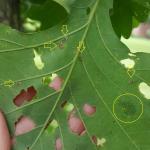
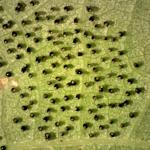
 Lace Bugs: Corythucha spp. and Stephanitis spp. lace bugs are active. Corythucha spp. utilize many hosts such as: hawthorn, cotoneaster, Amelanchier, quince, Pyracantha, various oaks, birch, maple, mountain ash, sycamore, hackberry, elm, walnut, butternut, basswood, etc. Corythucha spp. adult lace bugs were seen feeding on bur oak on 6/13/2018 in Amherst, MA. Many adult lace bugs were seen on leaf undersides, along with groups of tiny, black eggs. These groups of lace bug eggs were seen on nearly every leaf examined within reach on this tree. Eggs are so small they may look like fungal spores without magnification. In the included photos, note the feeding damage from gypsy moth present on the very same leaves.
Lace Bugs: Corythucha spp. and Stephanitis spp. lace bugs are active. Corythucha spp. utilize many hosts such as: hawthorn, cotoneaster, Amelanchier, quince, Pyracantha, various oaks, birch, maple, mountain ash, sycamore, hackberry, elm, walnut, butternut, basswood, etc. Corythucha spp. adult lace bugs were seen feeding on bur oak on 6/13/2018 in Amherst, MA. Many adult lace bugs were seen on leaf undersides, along with groups of tiny, black eggs. These groups of lace bug eggs were seen on nearly every leaf examined within reach on this tree. Eggs are so small they may look like fungal spores without magnification. In the included photos, note the feeding damage from gypsy moth present on the very same leaves.
Stephanitis spp. lace bugs are active and damage is becoming more apparent. Yellow stippling on leaf surfaces, black colored tar-like spots on leaf undersides, and lace bug nymphs (immatures) were seen on leaf undersides on 5/30/18, 6/7/18, and 6/13/18 in Amherst, MA on Rhododendron spp. foliage. Stephanitis spp. lacebugs such as S. pyriodes can cause severe injury to azalea foliage. S. rhododendri can be common on rhododendron and mountain laurel. S. takeyai has been found developing on Japanese Andromeda, Leucothoe, Styrax and willow. Stephanitis spp. lace bug activity should be monitored through September. Before populations become too large, treat with a summer rate horticultural oil spray as needed. Be sure to target the undersides of the foliage in order to get proper coverage of the insects. Fall or early spring soil treatment with imidacloprid has been effective, but be aware of the implications this may have on pollinators attracted to these flowering plants when making management decisions. Certain azalea and Andromeda cultivars may be less preferred by lace bugs.


 Lily Leaf Beetle: Lilioceris lilii overwintering adults continue to be active in Amherst, MA on 6/13/18. Susceptible hosts include Lilium spp. (Turk’s cap, tiger, Easter, Asiatic and Oriental lilies) and Fritillaria spp. (Note: daylilies are not hosts.) Typically, in May, mating will occur and each female will begin to lay 250-450 eggs in neat rows on the underside of the foliage. In Amherst, MA, orange lily leaf beetle eggs were observed on the underside of host plant foliage on 5/16/2018 and some of these eggs hatched by 5/23/18. Frass-covered larvae were observed feeding on 5/23/18, 5/30/18, 6/7/18, and 6/13/18 in Amherst, MA. Larvae are growing ever larger and eating entire leaves. Younger groups of eggs are hatching with still tiny larvae starting to feed by skeletonizing the leaf in groups. Where adults and larvae are seen, they can be removed from host plants with a gloved hand, where practical.
Lily Leaf Beetle: Lilioceris lilii overwintering adults continue to be active in Amherst, MA on 6/13/18. Susceptible hosts include Lilium spp. (Turk’s cap, tiger, Easter, Asiatic and Oriental lilies) and Fritillaria spp. (Note: daylilies are not hosts.) Typically, in May, mating will occur and each female will begin to lay 250-450 eggs in neat rows on the underside of the foliage. In Amherst, MA, orange lily leaf beetle eggs were observed on the underside of host plant foliage on 5/16/2018 and some of these eggs hatched by 5/23/18. Frass-covered larvae were observed feeding on 5/23/18, 5/30/18, 6/7/18, and 6/13/18 in Amherst, MA. Larvae are growing ever larger and eating entire leaves. Younger groups of eggs are hatching with still tiny larvae starting to feed by skeletonizing the leaf in groups. Where adults and larvae are seen, they can be removed from host plants with a gloved hand, where practical. - Roseslugs: Two species of sawfly can be found on the leaves of roses at this time. These small, caterpillar-like larvae will skeletonize the upper leaf surface and leave a “window-pane” like pattern behind. When present in large numbers, these insects are capable of defoliating their entire host. Management options include an insecticidal soap spray or a product containing spinosad. One species, Allantus cinctus, may require management again in mid-August; otherwise the window for management will pass typically by mid-June.
- Spotted Lanternfly: (Lycorma delicatula, SLF) is not known to occur in Massachusetts. This insect is a member of the Order Hemiptera (true bugs, cicadas, hoppers, aphids and others) and the Family Fulgoridae, also known as planthoppers. This insect is a non-native species first detected in the United States in Berks County, Pennsylvania and confirmed on September 22, 2014. Until November 2017, this invasive insect was only known to Pennsylvania. It has now been reported from Delaware (November 20, 2017), New York (November 29, 2017), and most recently in Virginia (January 10, 2018). The Delaware Department of Agriculture announced the finding of a single female spotted lanternfly in New Castle County in the Wilmington, Delaware area. At this time, officials in Delaware note that it is unclear if this individual was an accidental hitchhiker or evidence of an established population in the state. For more information about the find in Delaware, visit: https://news.delaware.gov/2017/11/20/spotted-lanternfly-confirmed-delaware/ . The New York State Department of Agriculture and Markets reported on November 29, 2017 the finding of a single dead individual spotted lanternfly in the state from earlier in the month. A single dead specimen was confirmed at a facility in Delaware County, New York, which is located south-west of Albany. The NYS Dept. of Agriculture and Markets states that this dead individual may have come in on an interstate shipment. For more information about the find in New York, visit: https://www.agriculture.ny.gov/AD/release.asp?ReleaseID=3637 . Most recently, Virginia Cooperative Extension announced the finding of a spotted lanternfly population in Frederick County, Virginia, on January 10, 2018. It was noted that at the location in Virginia, numerous adult lanternflies and egg masses were discovered, in addition to more at another site approximately 400 yards away. For more information about the find in Virginia, visit: https://ext.vt.edu/agriculture/commercial-horticulture/spotted-lanternfly.html .
The spotted lanternfly is considered native to China, India and Vietnam. It has been introduced as a non-native insect to South Korea and Japan prior to its detection in the United States. In South Korea it is considered invasive and a pest of grapes and peaches. The spotted lanternfly has been reported from over 70 species of plants, including the following: tree of heaven (Ailanthus altissima) (preferred host), apple (Malus spp.), plum, cherry, peach, apricot (Prunus spp.), grape (Vitis spp.), pine (Pinus spp.), pignut hickory (Carya glabra), sassafras (Sassafras albidum), serviceberry (Amelanchier spp.), slippery elm (Ulmus rubra), tulip poplar (Liriodendron tulipifera), white ash (Fraxinus americana), willow (Salix spp.), American beech (Fagus grandifolia), American linden (Tilia americana), American sycamore (Platanus occidentalis), big-toothed aspen (Populus grandidentata), black birch (Betula lenta), black cherry (Prunus serotina), black gum (Nyssa sylvatica), black walnut (Juglans nigra), dogwood (Cornus spp.), Japanese snowbell (Styrax japonicus), maple (Acer spp.), oak (Quercus spp.) and paper birch (Betula papyrifera).
The adults and immatures of this species damage host plants by feeding on sap from stems, leaves and the trunks of trees. In the springtime in Pennsylvania (late April - mid-May) nymphs (immatures) are found on smaller plants and vines and new growth of trees and shrubs. Third and fourth instar nymphs migrate to the tree of heaven and are observed feeding on trunks and branches. Trees may be found with sap weeping from the wounds caused by the insect’s feeding. The sugary secretions (excrement) created by this insect may coat the host plant, later leading to the growth of sooty mold. Insects such as wasps, hornets, bees and ants may also be attracted to the sugary waste created by the lanternflies, or sap weeping from open wounds in the host plant. Host plants have been described as giving off a fermented odor when this insect is present.
Adults are present by the middle of July in Pennsylvania and begin laying eggs by late September, continue laying eggs through late November and even early December in that state. Adults may be found on the trunks of trees such as the tree of heaven or other host plants growing in close proximity to them. Egg masses of this insect are gray in color and look similar to gypsy moth egg masses.
Host plants, bricks, stone, lawn furniture, recreational vehicles and other smooth surfaces can be inspected for egg masses. Egg masses laid on outdoor residential items such as those listed above may pose the greatest threat for spreading this insect via human aided movement.
For more information about the spotted lanternfly, visit this fact sheet: https://ag.umass.edu/landscape/fact-sheets/spotted-lanternfly .
- Spruce Spider Mite: Oligonychus ununguis is a cool-season mite that becomes active in the spring from tiny eggs that have overwintered on host plants. Hosts include spruce, arborvitae, juniper, hemlock, pine, Douglas-fir and occasionally other conifers. This particular species becomes active in the spring and can feed, develop and reproduce through roughly June. When hot, dry summer conditions begin, this spider mite will enter a summer-time dormant period (aestivation) until cooler temperatures return in the fall. This particular mite may prefer older needles to newer ones for food. Magnification is required to view spruce spider mite eggs. Tapping host plant branches over white paper may be a useful tool when scouting for spider mite presence. (View with a hand lens.) Spider mite damage may appear on host plant needles as yellow stippling and occasionally fine silk webbing is visible.
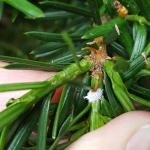 Taxus Mealybug: Dysmicoccus wistariae was spotted on taxus in Amherst on 5/23/18, 5/30/18, 6/7/18 and again on 6/13/2018. This insect will produce honeydew leading to sooty mold growth, yellowing of needles and sparsely foliated plants. Eventual dieback may be possible. This species is commonly associated with taxus in New England, but can be occasionally found on dogwood, rhododendron, Prunus spp., maple, Andromeda and crabapple. These mealybugs are found on stems and branches and particularly like to congregate at branch crotches. Management may be targeted between 246-618 GDD’s. Horticultural oil and neem oil may be used.
Taxus Mealybug: Dysmicoccus wistariae was spotted on taxus in Amherst on 5/23/18, 5/30/18, 6/7/18 and again on 6/13/2018. This insect will produce honeydew leading to sooty mold growth, yellowing of needles and sparsely foliated plants. Eventual dieback may be possible. This species is commonly associated with taxus in New England, but can be occasionally found on dogwood, rhododendron, Prunus spp., maple, Andromeda and crabapple. These mealybugs are found on stems and branches and particularly like to congregate at branch crotches. Management may be targeted between 246-618 GDD’s. Horticultural oil and neem oil may be used.
- Twolined Chestnut Borer: Agrilus bilineatus is a native jewel beetle (also known as a flatheaded borer) in the Family Buprestidae. This insect is also in the same genus as the invasive emerald ash borer. The twolined chestnut borer is native to Massachusetts, much of New England, and the eastern United States. This species has one generation per year and adults are typically active from April – August, depending upon location and temperature. Adults will conduct some maturation feeding on oak prior to mating. Females will lay clusters of tiny eggs in the cracks and crevices of bark. Larvae hatch from the eggs in 1-2 weeks and burrow through the bark into the cambium, where they feed in a similar manner to the emerald ash borer, creating meandering galleries as they feed. (The galleries of the twolined chestnut borer can be straight in very stressed trees.) Larvae typically mature by August – October and burrow to the outer bark where they create a chamber in which they overwinter. Pupation occurs the following spring and adults emerge through D-shaped exit holes that are approximately 1/5 inch wide. In the northern extent of this insect’s range, they can take 2 years to complete their life cycle. Larvae of this insect have been recorded from eastern white oak, common post oak, burr oak, scarlet oak, northern red oak and eastern black oak. Adults have been recorded on fir and pin oak. In the case of an individual adult twolined chestnut borer observed on 6/7/18 in Amherst, MA, it was lingering on an elm leaf. There are oaks nearby, so this could just be happenstance as the insect searches for a suitable host.These insects are attracted to stressed host plants and typically become a secondary factor in the decline of the tree.
- Viburnum Leaf Beetle: Pyrrhalta viburni is a beetle in the family Chrysomelidae that is native to Europe, but was found in Massachusetts in 2004. Viburnum leaf beetle egg hatch was observed in Boston, MA on 5/4/2018. By early to mid-June, viburnum leaf beetle larvae will crawl down the host plant, enter the soil surface, and pupate. This typically occurs when the larvae are just under ½ inch in length. (See indications of this occurring now in Regional Reports above.) After pupation, by early July, adult beetles will emerge from the soil and begin feeding on viburnum foliage again prior to mating and laying eggs. This beetle feeds exclusively on many different species of viburnum, which includes, but is not limited to, susceptible plants such as V. dentatum, V. nudum, V. opulus, V. propinquum, and V. rafinesquianum. Larvae, where they are present, may be treated with a product containing spinosad. Some viburnum have been observed to have varying levels of resistance to this insect, including but not limited to V. bodnantense, V. carlesii, V. davidii, V. plicatum, V. rhytidophyllum, V. setigerum, and V. sieboldii. More information about viburnum leaf beetle may be found at http://www.hort.cornell.edu/vlb/ .
- White Spotted Pine Sawyer (WSPS): Monochamus scutellatus adults can emerge in late May throughout July, depending on local temperatures. The first report of a white spotted pine sawyer adult came from the Asian Longhorned Beetle Eradication Program in Worcester, MA. A concerned citizen in Hampshire County, MA reported (with a photo) a white spotted pine sawyer adult on 5/22/2018. A second report of 3 white spotted pine sawyers came to UMass Extension from a concerned citizen in Hampden County, MA on 6/8/2018. The report was given with photos that clearly allowed for the insect to be identified. This report was shared with the ALB Eradication Program. This is a native insect in Massachusetts and is usually not a pest. Larvae develop in weakened or recently dead conifers, particularly eastern white pine (Pinus strobus). However, the adult white spotted pine sawyer looks very similar to the invasive Asian Longhorned Beetle, Anoplophora glabripennis, ALB. ALB adults do not typically emerge in Massachusetts until July and August. Beginning in July, look for the key difference between WSPS and ALB adults, which is a white spot in the top center of the wing covers (the scutellum) on the back of the beetle. White spotted pine sawyer will have this white spot, whereas Asian longhorned beetle will not. Both insects can have other white spots on the rest of their wing covers; however, the difference in the color of the scutellum is a key characteristic. See the Asian longhorned beetle entry above for more information about that non-native insect. (And where to go to report anything suspicious.)

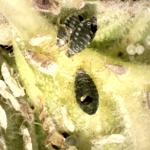 Woolly Apple Aphid: Eriosoma lanigerum may be found on apple, crabapple, hawthorn, mountain-ash, Pyracantha and elm hosts. The primary (winter) host is elm, on which aphids infest emerging spring leaf growth, causing leaves to curl or close into stunted, rosette-like clusters found at twig tips. Woolly apple aphid was again observed on elm on 6/13/2018 in Amherst, MA. On apple and crabapple, this species of aphid colonizes roots, trunks and branches in the summer and is commonly found near previous wounds or callous tissue. On roots, the aphids cause swelled areas which can girdle and kill roots. The aphids, when found in above ground plant parts such as elm leaves, are covered with white wax. Eggs are the overwintering stage on elm, which hatch in the spring in time for the nymphs to infest elm foliage. Following a few generations on elm, the aphids will develop into a winged form, which will disperse and seek out apple and crabapple. Small numbers of winged individuals were observed on elm on 5/31/2018 in Amherst, MA. These individuals were mixed with younger, non-winged aphids in their rosette-like deformed leaves. Small numbers of winged individuals were again observed on 6/13/18. Some of the aphids were also observed on this date to have succumbed to tiny parasitoid wasps. (See photos of aphid mummies included.) Multiple generations will occur on these alternate hosts in the summer and by the fall, a winged form will return to elm and mated females will lay eggs near elm buds.
Woolly Apple Aphid: Eriosoma lanigerum may be found on apple, crabapple, hawthorn, mountain-ash, Pyracantha and elm hosts. The primary (winter) host is elm, on which aphids infest emerging spring leaf growth, causing leaves to curl or close into stunted, rosette-like clusters found at twig tips. Woolly apple aphid was again observed on elm on 6/13/2018 in Amherst, MA. On apple and crabapple, this species of aphid colonizes roots, trunks and branches in the summer and is commonly found near previous wounds or callous tissue. On roots, the aphids cause swelled areas which can girdle and kill roots. The aphids, when found in above ground plant parts such as elm leaves, are covered with white wax. Eggs are the overwintering stage on elm, which hatch in the spring in time for the nymphs to infest elm foliage. Following a few generations on elm, the aphids will develop into a winged form, which will disperse and seek out apple and crabapple. Small numbers of winged individuals were observed on elm on 5/31/2018 in Amherst, MA. These individuals were mixed with younger, non-winged aphids in their rosette-like deformed leaves. Small numbers of winged individuals were again observed on 6/13/18. Some of the aphids were also observed on this date to have succumbed to tiny parasitoid wasps. (See photos of aphid mummies included.) Multiple generations will occur on these alternate hosts in the summer and by the fall, a winged form will return to elm and mated females will lay eggs near elm buds.
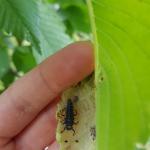 Woolly Elm Aphid: Eriosoma americanum females lay a single egg in the cracks and crevices of elm bark, where the egg overwinters. Eggs hatch on elm in the spring as leaves are unfolding. A young, wingless female hatched from the egg feeds on the underside of leaf tissue. This female aphid matures and gives birth to 200 young, all females, without mating. These aphids feed, and the elm leaf curls around them and protects them. Curled leaves, sheltering feeding, honeydew-producing aphids within, were observed on elm in Amherst, MA on 5/16/2018 and again on 5/23/2018. Oddly enough, on 5/31/2018 at the same location in Amherst, MA, a few winged individuals were seen within folded leaves. Most of the aphids were still wingless. By 6/13/18 in Amherst, MA, many of the woolly elm aphids observed within curled leaves were winged. They will clearly be ready to migrate to their alternate serviceberry hosts by the end of this month. See also the included image of a sated ladybeetle larva found within a curled elm leaf that was now mostly devoid of aphids. By the end of June, winged migrants mature and find serviceberry hosts. Another set of females will be produced. These new females crawl to and begin feeding on the roots of serviceberry. Multiple generations occur on the roots of serviceberry through the summer.
Woolly Elm Aphid: Eriosoma americanum females lay a single egg in the cracks and crevices of elm bark, where the egg overwinters. Eggs hatch on elm in the spring as leaves are unfolding. A young, wingless female hatched from the egg feeds on the underside of leaf tissue. This female aphid matures and gives birth to 200 young, all females, without mating. These aphids feed, and the elm leaf curls around them and protects them. Curled leaves, sheltering feeding, honeydew-producing aphids within, were observed on elm in Amherst, MA on 5/16/2018 and again on 5/23/2018. Oddly enough, on 5/31/2018 at the same location in Amherst, MA, a few winged individuals were seen within folded leaves. Most of the aphids were still wingless. By 6/13/18 in Amherst, MA, many of the woolly elm aphids observed within curled leaves were winged. They will clearly be ready to migrate to their alternate serviceberry hosts by the end of this month. See also the included image of a sated ladybeetle larva found within a curled elm leaf that was now mostly devoid of aphids. By the end of June, winged migrants mature and find serviceberry hosts. Another set of females will be produced. These new females crawl to and begin feeding on the roots of serviceberry. Multiple generations occur on the roots of serviceberry through the summer.
Concerned that you may have found an invasive insect or suspicious damage caused by one? Need to report a pest sighting? If so, please visit the Massachusetts Introduced Pests Outreach Project: http://massnrc.org/pests/pestreports.htm .
A note about Tick Awareness: deer ticks (Ixodes scapularis), the American dog tick (Dermacentor variabilis), and the lone star tick (Amblyomma americanum) are all found throughout Massachusetts. Each can carry their own complement of diseases. Anyone working in tick habitats (wood-line areas, forested areas, and landscaped areas with ground cover) should check themselves regularly for ticks while practicing preventative measures. Have a tick and need it tested? Visit the web page of the UMass Laboratory of Medical Zoology (https://www.tickreport.com/ ) and click on the red Test a Tick button for more information.
Reported by Tawny Simisky, Extension Entomologist, UMass Extension Landscape, Nursery, & Urban Forestry Program
Plant of the Week
It is after the end of bloom (currently) that this small tree puts on a long, interesting show: https://extension.umass.edu/plant-identification/smoketree
Report by Mandy Bayer, Extension Assistant Professor of Sustainable Landscape Horticulture, UMass Stockbridge School of Agriculture
Additional Resources
To receive immediate notification when the next Landscape Message update is posted, be sure to join our e-mail list and follow us on Facebook and Twitter.
For a complete listing of upcoming events, see our Upcoming Educational Events page.
For commercial growers of greenhouse crops and flowers - Check out UMass Extension's Greenhouse Update website
For professional turf managers - Check out Turf Management Updates
For home gardeners and garden retailers - Check out home lawn and garden resources. UMass Extension also has a Twitter feed that provides timely, daily gardening tips, sunrise and sunset times to home gardeners, see https://twitter.com/UMassGardenClip
Diagnostic Services
A UMass Laboratory Diagnoses Landscape and Turf Problems - The UMass Extension Plant Diagnostic Lab is available to serve commercial landscape contractors, turf managers, arborists, nurseries and other green industry professionals. It provides woody plant and turf disease analysis, woody plant and turf insect identification, turfgrass identification, weed identification, and offers a report of pest management strategies that are research based, economically sound and environmentally appropriate for the situation. Accurate diagnosis for a turf or landscape problem can often eliminate or reduce the need for pesticide use. For sampling procedures, detailed submission instructions and a list of fees, see Plant Diagnostics Laboratory
Soil and Plant Nutrient Testing - The University of Massachusetts Soil and Plant Nutrient Testing Laboratory is located on the campus of The University of Massachusetts at Amherst. Testing services are available to all. The function of the Soil and Plant Nutrient Testing Laboratory is to provide test results and recommendations that lead to the wise and economical use of soils and soil amendments. For complete information, visit the UMass Soil and Plant Nutrient Testing Laboratory web site. Alternatively, call the lab at (413) 545-2311.
Ticks are active at this time! Remember to take appropriate precautions when working and playing outdoors, and conduct daily tick checks. UMass tests ticks for the presence of Lyme disease and other disease pathogens. Learn more




